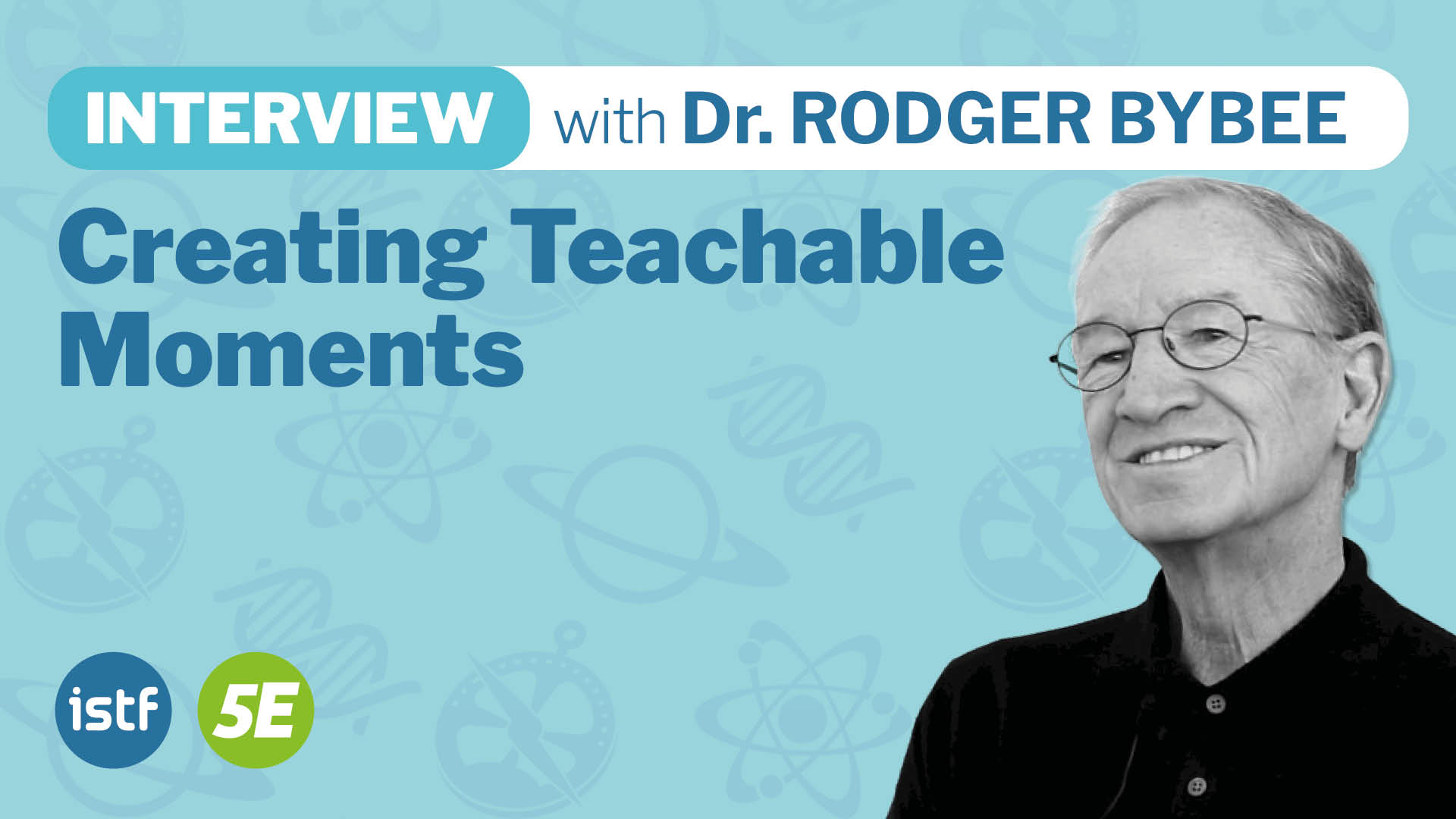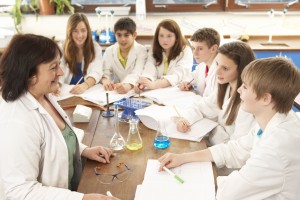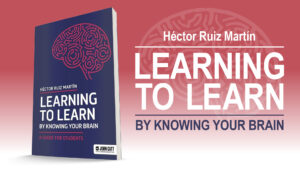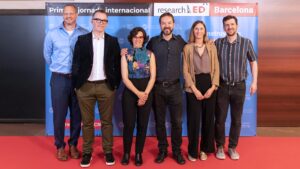
The 5E instructional model was developed in the 1980s by the Biological Sciences Curriculum Study team (BSCS) and has been used in several primary and secondary schools across the United States. Studies on the model have shown there to be significant improvements in conceptual learning, skills development, as well as greater interest in science by students. In this regard, a study carried out in 10 US states showed that the number of correct answers in biology exams by groups of students that had applied this model had increased by 40%.
 Dr. Rodger Bybee has recently published The BSCS 5E Instructional Model: Creating Teachable Moments (National Science Teachers Association). In this book, Dr. Bybee focuses on the implementation of the 5E Model in the classroom. The author also reviews the history of the different constructivist models of learning, the research studies that support the 5E Model, and links this model to 21st-century skills. In short, Dr. Bybee provides teachers with ways to improve their teaching experience in the classroom, making sure the different teachable moments are fully engaging for both teachers and students. With this book, teachers will learn ways in which to be more efficient in the classroom and make the best out of the different teachable moments that arise in this learning context.
Dr. Rodger Bybee has recently published The BSCS 5E Instructional Model: Creating Teachable Moments (National Science Teachers Association). In this book, Dr. Bybee focuses on the implementation of the 5E Model in the classroom. The author also reviews the history of the different constructivist models of learning, the research studies that support the 5E Model, and links this model to 21st-century skills. In short, Dr. Bybee provides teachers with ways to improve their teaching experience in the classroom, making sure the different teachable moments are fully engaging for both teachers and students. With this book, teachers will learn ways in which to be more efficient in the classroom and make the best out of the different teachable moments that arise in this learning context.
An INTERVIEW with Dr. Rodger Bybee
In your opinion, why is it important to teach science to every child?
So many things in our world, in the 21st century, are related to science. Major issues, major phenomena that we see, we experience, that influence citizens–including future scientists–, have some kind of scientific basis in them. I think it is really important for our citizens, whether in Spain, or in the United States, or wherever, to be able to develop the competence to use their science background to find concepts and apply them to everyday situations, such as: everyday situations of health and nutrition; of environment and resources; of natural hazards; things that we hear about almost every day in the newspaper; and to move, so the citizens have some knowledge and understanding of those as they have to apply their own knowledge in life situations.
What’s a “teachable moment”?
A “teachable moment” is when the teacher does something, in a context of the 5E Model, tha t is unexpected, that the student realizes they think they’re going to see one thing, and they see something very different. In the natural world, having an earthquake occur would be a teachable moment, and that’s natural phenomena; having the teacher do something that causes cognitive conflict, that’s a more complex term, for it’s unexpected. If I drop something, and it goes up, the student is going to go, “what is that?”, and you then should have a teachable moment.
t is unexpected, that the student realizes they think they’re going to see one thing, and they see something very different. In the natural world, having an earthquake occur would be a teachable moment, and that’s natural phenomena; having the teacher do something that causes cognitive conflict, that’s a more complex term, for it’s unexpected. If I drop something, and it goes up, the student is going to go, “what is that?”, and you then should have a teachable moment.
And how does the 5E Model of Instruction use these “teachable moments”? When are these moments produced, and what are the benefits of using them?
Two factors become important. The most concrete response to your question is, in the “Engage”, to think about something that really engages the students. It can be as simple as a question; it can be a demonstration that has some unexpected consequence or result. That’s the first step. The challenge then, and one of the things that I’ve tried to express across the 5E Model, is you sustain that engagement, and you put the pieces together for the student to learn: what it is that you are trying to teach them.
In your book when you were designing the 5E Model of Instruction, you wanted to start with an instructional model that was research-based, and you started with the idea of a Learning Cycle developed for the Science Curriculum Improvement Study. What kind of studies are behind these models? What kind of studies let us know that these models, like the 5E Model of Instruction, really work?
 The research that I first appealed to with the Science Curriculum Improvement Study, their learning outcomes: did students learn what it was that was in science curriculum improvement study? I had experience teaching that. I also knew Bob Karplus and Mike Atkin. They had conducted a whole series of research studies that had to do with, first, the fidelity to the different stages in their model; and basically, did the students learn? A very fundamental educational question in the end. The addition to that, that I put on, and one that I’ve mentioned to you is: what was the fidelity of the teacher’s use of the model in classrooms across time?
The research that I first appealed to with the Science Curriculum Improvement Study, their learning outcomes: did students learn what it was that was in science curriculum improvement study? I had experience teaching that. I also knew Bob Karplus and Mike Atkin. They had conducted a whole series of research studies that had to do with, first, the fidelity to the different stages in their model; and basically, did the students learn? A very fundamental educational question in the end. The addition to that, that I put on, and one that I’ve mentioned to you is: what was the fidelity of the teacher’s use of the model in classrooms across time?
Which one do you think is the key factor, the one that really makes a difference between a traditional model of instruction, based on transmission of knowledge, etc., and models like the 5E Model of instruction? I mean, if you had the opportunity to change just one teacher practice in the classroom, which one do you think would be the one that would grant the most significant change in the way teachers teach and then students learn?
That’s a difficult question, because it’s complex. I would say to engage the learner, and then without kind of elaborating all the rest of the 5E Model, to have the teacher pay very close attention to how the student responds to the phenomena in which he or she, the student, is engaged; and to carefully listen and address the current conceptions (referred to as misconceptions) of the students, and to help them reconstruct a way of thinking and explaining phenomena in the world. That’s a brief answer.
If you ask me how the teacher helps the students reconstruct their explanation, this requires some challenge. Where the student realizes there’s an inadequacy in the way they’re explaining the world, the phenomenon that they have witnessed, and a careful, almost clinical restructuring of how the student explains that, so the explanation is more scientific, that’s a fairly long answer.
The short answer would be lecturing isn’t the way that really facilitates the reconstruction: it’s a careful interaction between the teacher and the students in the classroom, especially as it focuses on some phenomena and some things that they’re doing, it may be an actual hands-on activity; it may be something that is assimilation, and using educational technology… It can be just the dialog between the teacher and the student; it can also be the dialog of student to student, challenging one another, and going back, and talking about, and having them explain to one another how the phenomenon occurs, what they understand about it, and so on.
How does the 5E Model of Instruction help teachers teach the 21st century skills?
First of all, how the 5E Model helps teachers. The first part of an answer to you is that teachers, they’re professionals, and their world is teaching. So, one of the reasons that I think the 5E Model has become very popular is it answers their questions: I have to teach. How do I teach better? If I engage, explore, explain, and so on… So, that is, at least part of it, answering the question for the teachers.
The second part, the 21st century skills–adaptability, complex communication, nonroutine problem solving, systems thinking–, are all available as learning outcomes when you use the 5E Model, and especially when you’re doing something that has some active mental engagement of students working as groups. So, they have to learn how to adapt to one another; they have to learn how to communicate; they have to learn how to solve problems; they have to apply systems thinking; and so on.











Me encanto la idea de aprender más acerca del modeló E5 y me encanta más saber sobre la metería de Ciencias así como me ayudará a aprender más acerca de ciertos temas
Apreciada Maricarmen,
Le agradecemos mucho su interés por nuestra entrevista con el doctor Rodger Bybee. Si desea saber más sobre las 5E puede visitar nuestro proyecto educativo Science Bits en http://www.science-bits.com. Un repositorio multimedia de lecciones de ciencias que promueve el uso de un modelo educativo constructivista basado en el desarrollo de las competencias educativas y el aprendizaje activo a través de la indagación, el descubrimiento, la reflexión y el razonamiento crítico. Las lecciones de Science Bits se han diseñado sobre el Modelo de Enseñanza de las 5E y el uso de una gran cantidad de recursos multimedia interactivos de alta calidad. Además, Science Bits utiliza herramientas de evaluación y seguimiento completo y continuo del aprendizaje de los estudiantes.
Este proyecto único ha ganado muchos de los mejores premios en tecnología y educación del mundo. Puedes ver más información en: https://science-bits.com/site/awards.php
También te puedes hacer una idea rápida de nuestro material en este vídeo: https://www.youtube.com/watch?v=hIk1IElnIyI 😉
Ahora ofrecemos acceso gratuito para todos los docentes interesados en continuar con sus clases de ciencias en línea durante esta crisis de #Covid19. Interesados deberían registrarse en: https://science-bits.com/site/covid.php
Gracias por contactar con nosotros.
¡Esperamos que te guste!
El equipo de la ISTF